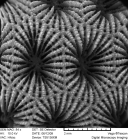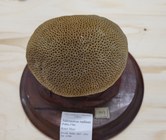
| About | | Search taxa | | Taxon tree | | Search literature | | Checklist | | Stats | | Log in |
WoRMS taxon detailsSiderastrea Blainville, 1830
204291 (urn:lsid:marinespecies.org:taxname:204291)
accepted
Genus
Madrepora galaxea Ellis & Solander, 1786 accepted as Siderastrea radians (Pallas, 1766) (type by monotypy)
Astraea (Siderastraea) Blainville, 1830 · unaccepted > superseded combination
Astraea (Siderina) Dana, 1846 · unaccepted > junior subjective synonym
Siderastraea Blainville, 1830 · unaccepted > misspelling - incorrect subsequent spelling
Siderastrea (Siderastrea) Blainville, 1830 · unaccepted > superseded combination
Siderina Dana, 1846 · unaccepted > junior subjective synonym
marine,
de Blainville, H. M. (1830). Zoophytes. In: Dictionnaire des sciences naturelles, dans lequel on traitre méthodiquement des differéns êtres de la nature, considérés soit en eux-mêmes, d'après l'état actuel de nos connoissances, soit relativement à l'utlité qu'en peuvent retirer la médicine, l'agriculture, le commerce et les arts. Edited by F. G. Levrault. Tome 60. Paris, Le Normat. Pp. 548, pls. 68. <em>Paris, 1830.</em> 60 : 1-546., available online at https://www.biodiversitylibrary.org/page/25318344 [details]
Description Colonies are usually massive, sometimes branching or encrusting. Corallites are cerioid, formed by extratentacular budding,...
Description Colonies are usually massive, sometimes branching or encrusting. Corallites are cerioid, formed by extratentacular budding, and are like those of Pseudosiderastrea, except that the walls are thicker, are composed of concentric rods, and septa do not fuse (Veron, 1986 <57>). [details]
Hoeksema, B. W.; Cairns, S. (2024). World List of Scleractinia. Siderastrea Blainville, 1830. Accessed through: World Register of Marine Species at: https://www.marinespecies.org/aphia.php?p=taxdetails&id=204291 on 2024-07-26
Date action by
original description
de Blainville, H. M. (1830). Zoophytes. In: Dictionnaire des sciences naturelles, dans lequel on traitre méthodiquement des differéns êtres de la nature, considérés soit en eux-mêmes, d'après l'état actuel de nos connoissances, soit relativement à l'utlité qu'en peuvent retirer la médicine, l'agriculture, le commerce et les arts. Edited by F. G. Levrault. Tome 60. Paris, Le Normat. Pp. 548, pls. 68. <em>Paris, 1830.</em> 60 : 1-546., available online at https://www.biodiversitylibrary.org/page/25318344 [details]
original description (of Astraea (Siderina) Dana, 1846) Dana, J.D. (1846-1849). Zoophytes. United States Exploring Expedition during the years 1838-1842. <em>Lea and Blanchard, Philadelphia.</em> 7: 1-740, 61 pls. (1846: 1-120, 709-720; 1848: 121-708, 721-740; 1849: atlas pls. 1-61)., available online at http://www.sil.si.edu/digitalcollections/usexex/navigation/ScientificText/USExEx19_08select.cfm [details] context source (Hexacorallia) Fautin, Daphne G. (2013). Hexacorallians of the World. (look up in IMIS) [details] basis of record Veron JEN. (1986). Corals of Australia and the Indo-Pacific. <em>Angus & Robertson Publishers.</em> [details] additional source Benzoni, F., Stefani, F., Pichon, M., Galli, P. 2010. The name game: morpho-molecular species boundaries in the genus Psammocora (Cnidaria, Scleractinia). Zoological Journal of the Linnean Society 160: 421-456. page(s): 429 [details] additional source Veron JEN. (2000). Corals of the World. Vol. 1–3. <em>Australian Institute of Marine Science and CRR, Queensland, Australia.</em> [details] additional source Medina, M.; Collins, A. G.; Takaoka, T. L.; Kuehl, J. V.; Boore, J. L. (2006). Naked corals: skeleton loss in Scleractinia. Proceedings of the National Academy of Sciences of the United States of America, 103(24): 9096-9100 page(s): 9097 [details]  Present Present  Inaccurate Inaccurate  Introduced: alien Introduced: alien  Containing type locality Containing type locality
Nontype (of Siderastraea Blainville, 1830) BMNH, geounit Taiwanese Exclusive Economic Zone [details]
From other sources
Description Colonies are usually massive, sometimes branching or encrusting. Corallites are cerioid, formed by extratentacular budding, and are like those of Pseudosiderastrea, except that the walls are thicker, are composed of concentric rods, and septa do not fuse (Veron, 1986 <57>). [details]
|


